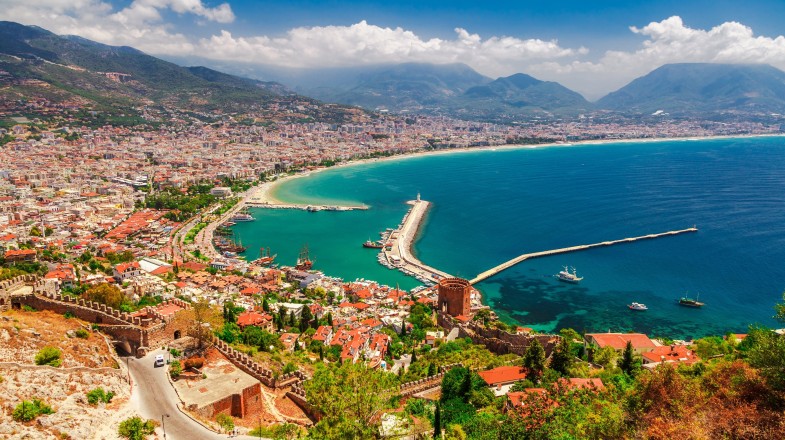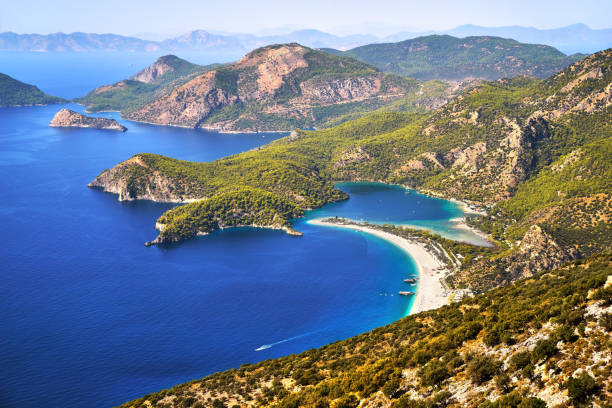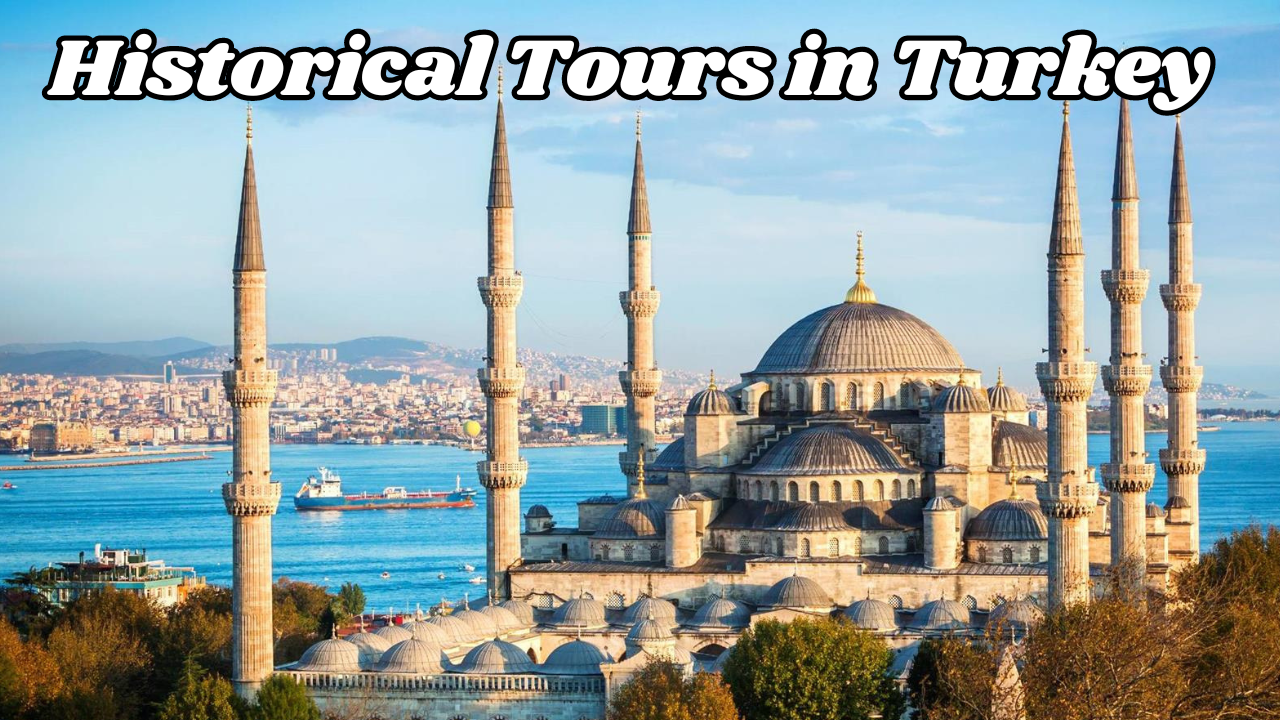Table of Contents
Introduction
Turkey’s historical richness is a tapestry woven with threads from ancient civilizations, empires, and cultural exchanges. Exploring Turkey through historical tours is akin to embarking on a captivating journey through time, unraveling the layers of its diverse heritage and deep-rooted traditions. From the bustling streets of Istanbul to the ancient ruins of Ephesus, the surreal landscapes of Cappadocia, and the historical marvels of Pamukkale, Turkey offers a treasure trove of historical sites waiting to be discovered.
In this exploration of historical tours in Turkey, we delve into the iconic landmarks and hidden gems that showcase the country’s millennia-old legacy. Each site carries with it stories of conquests, innovations, artistic endeavors, and the interplay of civilizations, offering invaluable insights into Turkey’s cultural tapestry and historical evolution. Join us on a virtual journey through Turkey’s historical wonders, where the past comes alive and history whispers its timeless tales.
Brief Overview of Rich Historical Tours in Turkey
Turkey’s historical heritage is a mosaic of civilizations that have left their indelible mark on the land. From the ancient Hittites and Greeks to the Byzantine and Ottoman empires, Turkey’s history spans thousands of years and encompasses a diverse array of cultures, religions, and traditions. The country’s strategic location at the crossroads of Europe, Asia, and the Middle East has made it a melting pot of influences, shaping its unique identity.
Turkey boasts a wealth of archaeological sites, ancient cities, and architectural wonders that reflect its rich historical tapestry. From the grandeur of Hagia Sophia and the Topkapi Palace in Istanbul to the ancient ruins of Ephesus, Troy, and Perge, each site tells a story of bygone eras and historical milestones. The intricate designs of mosques, the sprawling Roman theaters, and the elaborate mosaics in Byzantine churches all contribute to Turkey’s cultural richness and historical significance.
Importance of Historical Tours in Understanding Turkey’s Cultural Legacy
Historical tours play a pivotal role in unraveling Turkey’s cultural legacy and preserving its historical heritage. These tours offer immersive experiences that allow visitors to walk in the footsteps of ancient civilizations, explore archaeological wonders, and gain a deeper understanding of Turkey’s diverse cultural mosaic.
By visiting historical sites such as Ephesus, Cappadocia, and Pamukkale, travelers can witness firsthand the architectural marvels, artistic achievements, and societal advancements of past civilizations. Through guided tours, informative exhibits, and expert insights, visitors can learn about Turkey’s historical significance, its contributions to art, architecture, and philosophy, and the interconnectedness of different cultures throughout history.
Moreover, historical tours foster cultural appreciation, promote heritage conservation, and contribute to local economies by encouraging tourism. They serve as educational experiences that inspire curiosity, spark dialogue, and promote cross-cultural understanding. Ultimately, historical tours in Turkey not only showcase the country’s rich heritage but also serve as a bridge between the past and the present, connecting people from around the world to Turkey’s enduring cultural legacy.
Istanbul

Istanbul, formerly known as Constantinople, stands as a testament to Turkey’s rich historical and cultural heritage. This vibrant city straddles two continents, bridging the gap between Europe and Asia, and is a treasure trove of historical landmarks. One of its most iconic sites is the Hagia Sophia, a marvel of Byzantine architecture that has witnessed centuries of history. Originally built as a cathedral in the 6th century, it later became a mosque during the Ottoman era and is now a museum, showcasing a blend of Christian and Islamic influences in its design and decor.
Another highlight of Istanbul is the Topkapi Palace, a magnificent complex that served as the administrative and residential center of the Ottoman sultans for centuries. The palace’s opulent courtyards, intricate tile work, and priceless collections of artifacts offer a glimpse into the lavish lifestyle of the Ottoman Empire. From the Harem to the Imperial Treasury, each section of Topkapi Palace tells a story of power, luxury, and artistic prowess, making it a must-visit destination for history enthusiasts and cultural aficionados alike.
Hagia Sophia
- History and Significance: Hagia Sophia, originally built as a Christian cathedral in the 6th century under Emperor Justinian I, stands as a symbol of Byzantine grandeur and religious devotion. Its construction marked a pinnacle of Byzantine architecture, showcasing a massive dome, intricate mosaics, and innovative structural engineering for its time. When Constantinople fell to the Ottomans in 1453, Hagia Sophia was converted into a mosque, further enriching its historical and cultural significance. In 1935, it was transformed into a museum, reflecting Turkey’s diverse heritage and serving as a bridge between its Christian and Islamic past.
- Architectural Features: Hagia Sophia’s architectural brilliance lies in its vast dome, which was a groundbreaking achievement in engineering during the Byzantine era. The dome appears to float ethereally above the vast interior space, supported by massive piers and semidomes. Intricate mosaics depicting religious scenes, calligraphy from Islamic periods, and marble columns add to the artistic allure of the structure. The blend of Byzantine, Ottoman, and Islamic architectural elements makes Hagia Sophia a masterpiece of cultural synthesis, attracting visitors from around the world to marvel at its timeless beauty and historical significance.
Topkapi Palace
- Ottoman History and Architecture: Topkapi Palace, perched on a hill overlooking the Bosphorus, served as the political and administrative center of the Ottoman Empire for nearly four centuries. Constructed in the 15th century by Sultan Mehmed II, the palace complex features a series of courtyards, pavilions, and gardens that reflect the opulence and power of the Ottoman sultans. Its architectural style blends traditional Ottoman design with influences from Persian, Arabic, and European architecture, creating a unique and visually stunning ensemble.
- Museum Highlights: Today, Topkapi Palace operates as a museum, offering visitors a glimpse into the lavish lifestyle of the Ottoman rulers and the empire’s rich cultural heritage. Highlights of the museum include the Imperial Treasury, showcasing priceless jewels and artifacts, the Harem, revealing the private quarters of the sultans and their families, and the Sultan’s Audience Chamber, adorned with exquisite tiles and intricate decorations. Each section of the palace-museum unveils facets of Ottoman history, art, and craftsmanship, making it a captivating destination for history buffs and art enthusiasts seeking to delve into Turkey’s imperial past.
Western Turkey

Western Turkey is a region steeped in ancient history, with a wealth of archaeological sites and historical landmarks that showcase its rich cultural heritage. One of the most prominent destinations in this region is Ephesus, an ancient Greek and Roman city renowned for its well-preserved ruins and historical significance. Visitors to Ephesus can explore the grandeur of the Temple of Artemis, one of the Seven Wonders of the Ancient World, along with the impressive Library of Celsus, the Great Theater, and the Terrace Houses, providing insights into daily life in ancient times.
Another captivating site in Western Turkey is Pamukkale, known for its surreal white terraces formed by thermal springs. Besides its natural beauty, Pamukkale is home to the ancient city of Hierapolis, boasting well-preserved Roman ruins, including a theater, necropolis, and Roman baths. The juxtaposition of natural wonders and ancient history makes Western Turkey a fascinating region to explore, offering a harmonious blend of cultural immersion and scenic landscapes for history enthusiasts and nature lovers alike.
Ephesus
- Greek and Roman History: Ephesus, located in western Turkey, is an archaeological treasure trove that bears witness to both Greek and Roman civilizations. Initially founded as an ancient Greek city, Ephesus flourished during the Roman era and became one of the largest cities in the Mediterranean region. Its strategic location on the Aegean coast facilitated trade and cultural exchanges, shaping Ephesus into a center of commerce, culture, and learning.
- Temple of Artemis: Among Ephesus’ notable landmarks is the Temple of Artemis, dedicated to the Greek goddess of hunting and fertility. This magnificent temple was one of the Seven Wonders of the Ancient World, renowned for its size and grandeur. Although only fragments remain today, the Temple of Artemis serves as a testament to the ancient Greeks’ architectural prowess and religious devotion, attracting visitors keen on exploring the site’s historical and mythological significance.
Pamukkale and Hierapolis
- Natural and Historical Wonders: Pamukkale, meaning “Cotton Castle” in Turkish, is a natural marvel characterized by its terraces of white travertine formed by calcium-rich thermal springs. This surreal landscape, resembling a cascading snowy slope, is not only a visual spectacle but also holds therapeutic properties, making it a popular destination for wellness seekers. Adjacent to Pamukkale is Hierapolis, an ancient city founded by the Greeks and later expanded by the Romans. The combination of Pamukkale’s natural beauty and Hierapolis’ historical ruins creates a unique blend of natural and historical wonders for visitors to explore.
- Roman Ruins and Thermal Springs: Hierapolis boasts well-preserved Roman ruins, including a theater, temples, gates, and a necropolis with impressive tombs and sarcophagi. The ancient city’s strategic location near Pamukkale’s thermal springs made it a popular spa destination in antiquity, attracting visitors seeking healing and relaxation. Today, visitors can wander through the ancient streets of Hierapolis, marvel at its architectural remains, and even take a dip in the rejuvenating thermal pools, experiencing the seamless integration of history, nature, and wellness in Pamukkale and Hierapolis.
Cappadocia

Cappadocia, located in central Turkey, is a region renowned for its surreal landscapes, ancient cave dwellings, and rich historical heritage. The unique geological formations known as “fairy chimneys” dot the landscape, creating a magical and otherworldly ambiance. These cone-shaped rock formations were shaped by volcanic eruptions and erosion over millions of years, resulting in a captivating sight that attracts travelers from around the globe. Beyond its natural beauty, Cappadocia holds a deep historical significance, especially in early Christian history. The region is dotted with rock-cut churches adorned with intricate frescoes, some dating back over a thousand years, offering insights into the religious and artistic heritage of the area.
One of the most fascinating aspects of Cappadocia is its underground cities, which served as refuge and defense systems for ancient inhabitants. These underground complexes, such as Derinkuyu and Kaymakli, were carved into the soft volcanic rock and could accommodate thousands of people along with their livestock and provisions. Exploring these underground cities provides a glimpse into the daily life, architecture, and strategic ingenuity of past civilizations. Cappadocia’s blend of natural wonders and historical marvels makes it a captivating destination for travelers seeking both adventure and cultural immersion.
Unique Geological Formations
- Fairy Chimneys and Rock-Cut Churches: Cappadocia’s landscape is defined by its extraordinary geological formations, particularly the fairy chimneys. These tall, cone-shaped rock formations were sculpted over centuries by volcanic eruptions and erosion, creating a whimsical and enchanting scenery that is unlike anywhere else in the world. Moreover, Cappadocia is home to numerous rock-cut churches, where early Christians sought refuge and practiced their faith. These churches, adorned with intricate frescoes depicting religious scenes, showcase the blend of natural beauty and human ingenuity that defines Cappadocia’s cultural heritage.
Underground Cities
- History and Purpose: Cappadocia’s underground cities, such as Derinkuyu and Kaymakli, date back to ancient times and were built by early inhabitants as shelters and defensive structures. These underground complexes served various purposes, including protection from invasions, persecution, and harsh weather conditions. The cities were equipped with ventilation shafts, wells, storage rooms, and interconnected tunnels, reflecting the resourcefulness and strategic planning of their builders.
- Exploration Opportunities: Today, visitors to Cappadocia have the unique opportunity to explore these ancient underground cities, delving deep into the subterranean world and experiencing firsthand the ingenuity of past civilizations. Guided tours lead visitors through narrow tunnels, hidden chambers, and intriguing architectural features, providing insights into the daily life and survival strategies of ancient Cappadocians. The exploration of underground cities in Cappadocia is not only an adventure into history but also a testament to human resilience and adaptation in the face of challenging environments.
Southern Turkey

Southern Turkey is a region rich in history, culture, and natural beauty, offering a diverse array of experiences for travelers. One of the prominent historical destinations in this region is Perge, an ancient city near Antalya with well-preserved Roman ruins. Visitors to Perge can explore the remains of a Roman stadium, theater, baths, and intricate architectural details that reflect the city’s former glory. The site provides a fascinating glimpse into Roman urban planning, engineering, and artistic achievements, making it a must-visit for history enthusiasts.
Another highlight of Southern Turkey is Aspendos, famous for its remarkably preserved Roman theater, still used for performances today. This ancient theater showcases the architectural prowess of the Romans, with its excellent acoustics and intricate design. Beyond its historical significance, Southern Turkey boasts picturesque coastal towns, stunning beaches, and rugged landscapes that attract nature lovers and adventure seekers. The blend of historical wonders and natural splendor makes Southern Turkey a captivating destination for travelers seeking a diverse and immersive experience.
Perge
- Roman Ruins and Architecture: Perge, located near Antalya in Southern Turkey, is renowned for its well-preserved Roman ruins and architectural marvels. The site showcases remnants of a once-thriving ancient city, including impressive colonnades, temples, and public buildings. Visitors can marvel at the intricate details of Roman architecture, such as the finely carved reliefs and ornate columns, providing a glimpse into the artistic and engineering skills of the Romans.
- Stadium and Theater: One of the highlights of Perge is its well-preserved Roman stadium, which could accommodate thousands of spectators and hosted various athletic competitions and events. Additionally, the city boasts a magnificent theater with tiered seating and excellent acoustics, where performances and entertainment were held in ancient times. Exploring these structures offers insight into the social and cultural life of the Roman era, making Perge a fascinating destination for history enthusiasts.
Aspendos
- Well-Preserved Roman Theater: Aspendos is renowned for its remarkably well-preserved Roman theater, considered one of the best-preserved ancient theaters in the world. Built during the reign of Marcus Aurelius in the 2nd century AD, the theater boasts impressive architectural features, including its horseshoe-shaped seating area, stage, and decorative elements. Visitors can admire the theater’s grandeur and imagine the performances and spectacles that once took place within its walls.
- Cultural Performances: In addition to its historical significance, Aspendos continues to be a cultural hub, hosting various performances and events, including concerts, operas, and theatrical productions. The theater’s excellent acoustics make it an ideal venue for musical and artistic performances, attracting both locals and tourists seeking a unique cultural experience. Attending a performance at Aspendos allows visitors to connect with Turkey’s rich artistic heritage while surrounded by ancient history and architectural splendor.
Eastern Turkey

Eastern Turkey is a region steeped in ancient history and cultural diversity, offering a unique blend of archaeological wonders, natural landscapes, and cross-cultural influences. One of the most significant historical sites in this region is Göbekli Tepe, considered one of the world’s oldest known temples and a UNESCO World Heritage Site. Dating back over 11,000 years, Göbekli Tepe provides invaluable insights into early human civilization, religious practices, and monumental architecture, challenging conventional notions about the origins of organized societies.
Another captivating destination in Eastern Turkey is Ani, an ancient city near the Armenian border that was once a thriving medieval metropolis. Today, Ani’s ruins stand as a testament to its former glory, with remnants of churches, mosques, city walls, and palaces showcasing a rich blend of Armenian, Byzantine, and Islamic architecture. Exploring Ani allows visitors to trace the region’s historical trajectory, from its medieval heyday as a bustling trading hub to its eventual decline and abandonment, offering a fascinating glimpse into the crossroads of civilizations in Eastern Turkey.
Göbekli Tepe
- Early Human Civilization: Göbekli Tepe is a remarkable archaeological site in Eastern Turkey that sheds light on early human civilization. Dating back to the Pre-Pottery Neolithic period, approximately 11,000 years ago, Göbekli Tepe predates Stonehenge and the Egyptian pyramids, making it one of the oldest known monumental structures built by humans. The site’s discovery revolutionized archaeological understanding, suggesting that complex societies and religious practices emerged earlier than previously believed.
- Archaeological Significance: Göbekli Tepe’s archaeological significance cannot be overstated. The site consists of monumental stone pillars, some adorned with intricate carvings of animals and symbols, arranged in circular patterns. These structures, likely used for ceremonial or ritual purposes, challenge conventional narratives about the transition from hunter-gatherer societies to settled agricultural communities. Göbekli Tepe’s discovery has prompted reevaluations of human cultural development, social organization, and the origins of religious beliefs, making it a focal point of archaeological research and fascination.
Ani
- Medieval City Ruins: Ani, often referred to as the “City of 1001 Churches,” was a flourishing medieval city located near the Armenian border in Eastern Turkey. Today, Ani’s ruins stand as a hauntingly beautiful testament to its former grandeur, with remnants of churches, palaces, city walls, and other structures scattered across the landscape. The city’s strategic location along trade routes contributed to its prosperity, attracting diverse populations and fostering cultural exchange.
- Cross-Cultural Influences: Ani’s ruins reflect a rich tapestry of cross-cultural influences, blending Armenian, Byzantine, Seljuk, and Islamic architectural styles and artistic motifs. The churches of Ani, adorned with intricate carvings, frescoes, and ornate decorations, showcase the fusion of Christian and Islamic artistic traditions. The city’s decline and eventual abandonment in the 14th century were due to various factors, including invasions, political upheavals, and demographic shifts. Exploring Ani’s ruins allows visitors to appreciate the interconnectedness of cultures and civilizations in Eastern Turkey’s historical landscape, highlighting the region’s diverse heritage and historical complexities.
Conclusion
Exploring Turkey through historical tours is not merely a journey through time but an immersive experience that unravels the intricate layers of its rich cultural tapestry. From the ancient ruins of Ephesus and the surreal landscapes of Cappadocia to the opulent palaces of Istanbul and the ancient cities of Perge and Ani, Turkey offers a treasure trove of historical wonders waiting to be discovered. These historical tours not only showcase Turkey’s remarkable heritage but also serve as windows into the evolution of human civilization, religious beliefs, architectural marvels, and cultural exchanges that have shaped the country’s identity. Each historical site, whether a Roman theater, a Byzantine cathedral-turned-museum, or an ancient underground city, carries with it stories of triumphs, innovations, and the enduring legacy of past civilizations. Moreover, historical tours in Turkey foster cultural appreciation, promote heritage conservation, and facilitate cross-cultural understanding, making them invaluable experiences for travelers seeking to delve deeper into the mosaic of Turkey’s history and cultural legacy. Whether you’re a history enthusiast, an art aficionado, or simply curious about the past, Turkey’s historical tours offer a captivating journey filled with insights, discoveries, and a renewed appreciation for the enduring spirit of human creativity and ingenuity.
Read more Historical Tours in Iran
